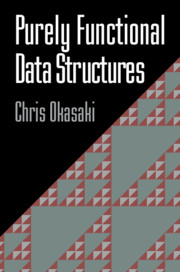Book contents
- Frontmatter
- Contents
- Preface
- 1 Introduction
- 2 Persistence
- 3 Some Familiar Data Structures in a Functional Setting
- 4 Lazy Evaluation
- 5 Fundamentals of Amortization
- 6 Amortization and Persistence via Lazy Evaluation
- 7 Eliminating Amortization
- 8 Lazy Rebuilding
- 9 Numerical Representations
- 10 Data-Structural Bootstrapping
- 11 Implicit Recursive Slowdown
- A Haskell Source Code
- Bibliography
- Index
5 - Fundamentals of Amortization
Published online by Cambridge University Press: 17 September 2009
- Frontmatter
- Contents
- Preface
- 1 Introduction
- 2 Persistence
- 3 Some Familiar Data Structures in a Functional Setting
- 4 Lazy Evaluation
- 5 Fundamentals of Amortization
- 6 Amortization and Persistence via Lazy Evaluation
- 7 Eliminating Amortization
- 8 Lazy Rebuilding
- 9 Numerical Representations
- 10 Data-Structural Bootstrapping
- 11 Implicit Recursive Slowdown
- A Haskell Source Code
- Bibliography
- Index
Summary
Over the past fifteen years, amortization has become a powerful tool in the design and analysis of data structures. Implementations with good amortized bounds are often simpler and faster than implementations with comparable worst-case bounds. In this chapter, we review the basic techniques of amortization and illustrate these ideas with a simple implementation of FIFO queues and several implementations of heaps.
Unfortunately, the simple view of amortization presented in this chapter breaks in the presence of persistence―these data structures may be extremely inefficient when used persistently. In practice, however, many applications do not require persistence, and for those applications, the implementations presented in this chapter are excellent choices. In the next chapter, we will see how to reconcile the notions of amortization and persistence using lazy evaluation.
Techniques of Amortized Analysis
The notion of amortization arises from the following observation. Given a sequence of operations, we may wish to know the running time of the entire sequence, but not care about the running time of any individual operation. For instance, given a sequence of n operations, we may wish to bound the total running time of the sequence by O(n) without insisting that every individual operation run in O(1) time. We might be satisfied if a few operations run in O(log n) or even O(n) time, provided the total cost of the sequence is only O(n).
Information
- Type
- Chapter
- Information
- Purely Functional Data Structures , pp. 39 - 56Publisher: Cambridge University PressPrint publication year: 1998
